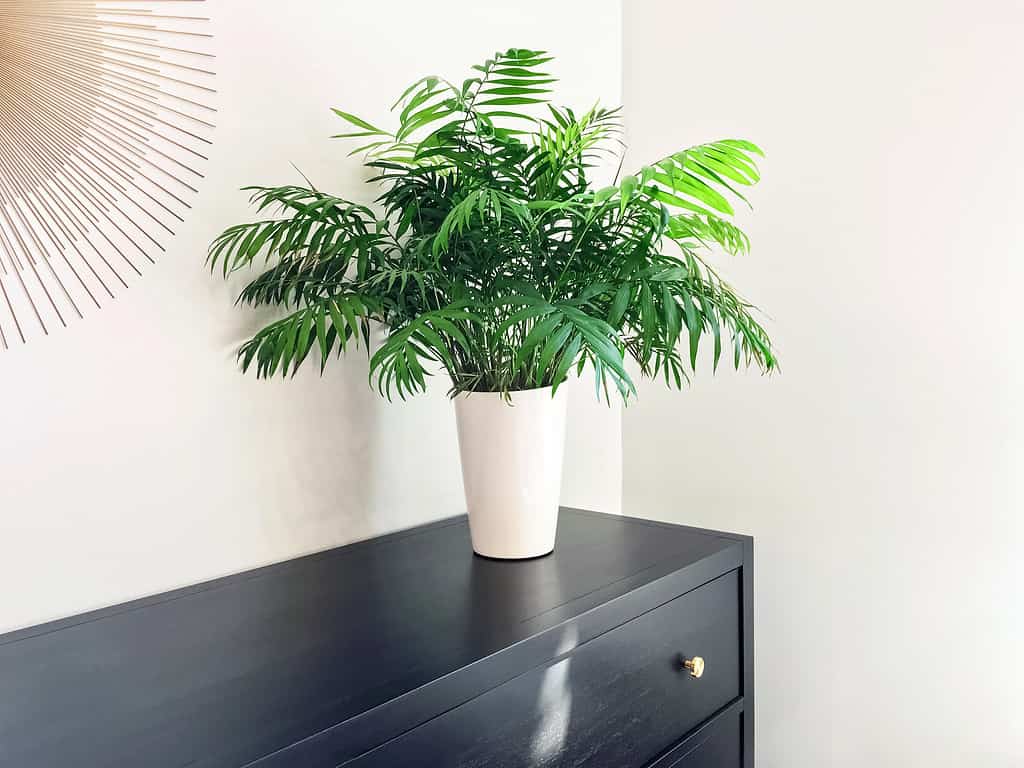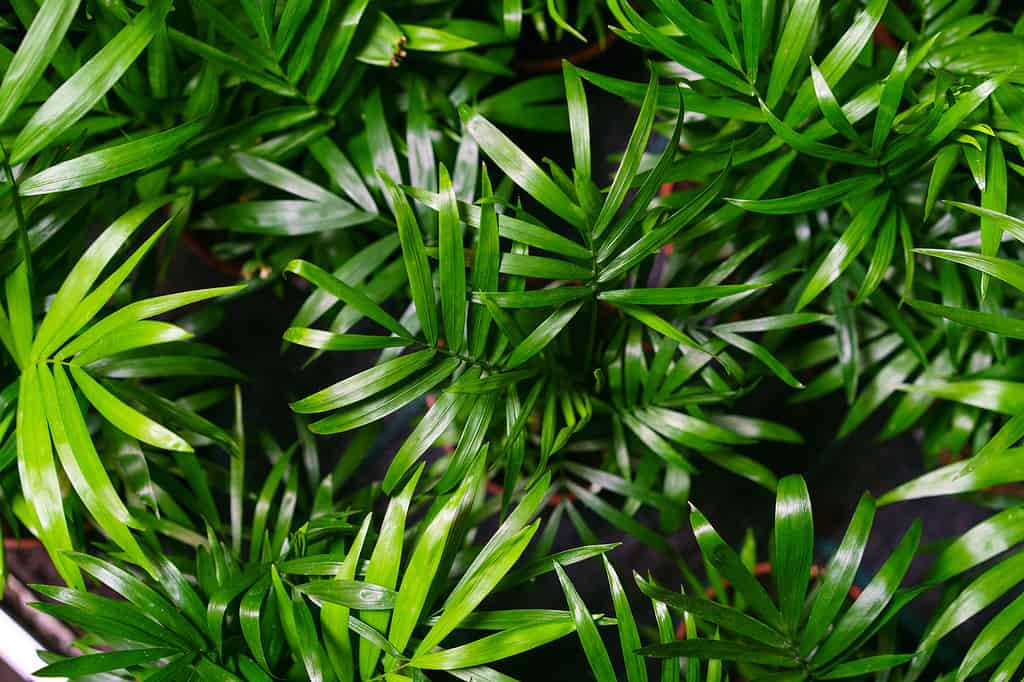A Parlor Palm (Chamaedorea elegans) is a tropical perennial evergreen. It has slender stems and long arching fronds and grows up to 3-6 feet tall indoors. While it can be grown outdoors in warmer climates, it’s most commonly kept as an indoor houseplant. It makes for a great low-maintenance indoor plant. This is mainly due to its minimal light requirements and its ability to thrive without much fertilizer or water.
The Bamboo Palm (Chamaedorea seifrizii) is also known as the Reed palm or Clustered parlor palm. It has a similar appearance to the Parlor Palm. Its dark green leaves have delicate leaflets that form clusters at their ends, making them look like bamboo shoots. Unlike the Parlor palm, which grows upwards, this type of palm prefers indirect sunlight when indoors and will reach heights of around 4-7 feet when given enough space to spread outwards. They are extremely resilient plants requiring little maintenance once established in their environment. Both palms make excellent additions to any home interior, providing beautiful greenery that doesn’t require too much effort! But there are some slight differences between them, which we will discuss in detail below.
Parlor Palm vs. Bamboo Palm

The Parlor Palm (
Chamaedorea elegans) is a tropical perennial evergreen.
©iStock.com/Wheatfield
Both of these palms come from the genus Chamaedorea and are native to the same regions. They are both tropical plants that like warm temperatures and high humidity. They are slightly different regarding height, growth pattern, and care requirements.
| Characteristic | Parlor Palm | Bamboo Palm |
|---|---|---|
| Scientific Name | Chamaedorea elegans | Chamaedorea seifrizii |
| Height | Indoor 3-4 feet tall. Outdoors 9 feet. | Indoor 4-7 feet tall. Outdoors 20 feet. |
| Light Requirements | Bright, indirect light | Low or Medium Light |
| Water Requirements | Dry slightly between waterings | Continuously moist soil |
| Toxicity | not toxic. Can cause skin irritation | not toxic. Can cause skin irritation |
| Growth Pattern | Multi-stemmed and herbaceous | Clumping and woody |
| Origins | Mexico through Honduras | Mexico through Honduras |
| USDA Hardiness | Zones 10a through 12b | Zones 10a through 12b |
| Flowers | Yellow and orange | Yellow and orange |
| Soil | Lightweight and aerated soil that is rich in compost and well-draining | Lightweight and aerated soil that is rich in compost and well-draining |
| Humidity | High humidity required | High humidity required |
Key Differences Between Parlor Palm vs. Bamboo Palm
The key differences between the parlor palm and the bamboo palm are growth height (bamboo palm is taller), light requirements (parlor palm likes brighter light), and watering requirements (bamboo palm likes continuously moist soil). We will describe this in detail for you below.
Parlor Palm vs. Bamboo Palm: Height
The parlor palm, also known as the Neanthe bella palm or Chamaedorea elegans, is an evergreen perennial plant that typically grows to a height of between 3-6 feet indoors. Outdoors in nature, however, parlor palms can grow much taller and reach heights of up to 10 feet under optimal conditions. The bamboo palm (Chamaedorea seifrizii) is slightly taller than the parlor palm indoors, with a typical height of between 4-7 feet. In nature, this species can grow to heights of 20 feet tall, depending on its environment and the availability of resources such as water and sunlight.
Parlor Palm vs. Bamboo Palm: Growth Pattern

The bamboo palm (
Chamaedorea seifrizii) is also native to tropical regions of Mexico and South America.
©Oksana Lyskova/Shutterstock.com
The growth patterns of the parlor palm and bamboo palm are quite different. The parlor palm is typically a multi-stemmed, herbaceous plant with thin, green stems that reach average heights of up to four feet indoors. Its fronds have slender leaflets and grow outward in an arching pattern. In contrast, the bamboo palm is a clumping and woody species with larger leaves than the parlor palm. It grows much slower but can reach heights of 7 feet or more if given enough time and space indoors. It also has thicker trunks compared to other palms, making it ideal for areas with little room for large plants like those found outdoors. Both plants make great additions to any indoor setting, but knowing their unique growth patterns should help you decide which would best suit your home or office environment.
Native Region
The parlor palm (Chamaedorea elegans) is native to the rainforests of Central America, particularly Mexico and Guatemala. The bamboo palm (Chamaedorea seifrizii) is also native to tropical regions of Mexico and South America. Although both plants are from similar areas, they have slightly different care requirements, which we will review in more detail.
Light Requirements

While still thriving in lower natural or artificial light levels, the parlor palm will not reach its full potential if grown in complete shade.
©Studio Light and Shade/Shutterstock.com
The parlor palm is an indoor plant that prefers bright, indirect light. A south or east-facing window is ideal for providing a balance of light without direct sunlight. If you can’t access such a window, artificial lighting can be used instead. When it comes to the bamboo palm, it also prefers bright and indirect light but is slightly more tolerant of low-light conditions than a parlor palm. It will still thrive in lower levels of natural or artificial light but will not reach its full potential if grown in complete shade over long periods of time.
Water and Humidity Requirements
The parlor palm is more drought-tolerant and only needs to be watered when the top inch of soil has dried out. It does not like to stay continually moist. The bamboo palm prefers consistently moist soil, so it should be checked regularly for moisture levels and watered as needed. Both plants require high humidity and well-draining soil in order to thrive indoors. If either plant is exposed to too low of a humidity level or planted in poorly draining soil, its health will suffer significantly. To ensure optimal growth and health for both plants, they should be kept away from drafts and fans and planted in a soil medium with plenty of perlite or vermiculite for drainage.
Flowers
The parlor palm (Chamaedorea elegans) produces small yellow and orange flowers that are clustered together at the end of the stems. The bamboo palm (Chamaedorea seifrizii) has a similar flower but is slightly larger than the parlor palm’s flower. The bamboo palm’s flowers tend to be a brighter shade of yellow or orange, while those of the parlor palms may have more muted colors. Both plants produce flowers during their blooming season, typically in late spring or early summer when temperatures begin to rise.
Toxicity

Close-up on the leaves of a bamboo palm (
chamaedorea seifrizii).
©Pereslavtseva Katerina/Shutterstock.com
Parlor palms and bamboo palms are not considered toxic if ingested. However, some people may experience an upset stomach or skin irritation due to their sap. As such, it is best to keep them away from children and pets who might be tempted to bite or eat the leaves of these plants. Additionally, the sap can cause skin irritation in humans, so gloves should be worn when handling these plants. Proper care should also be taken when removing dead leaves as they can contain dust that could irritate eyes or nasal passages.
USDA Zone
The USDA Hardiness Zone system is an important factor to consider when planting any type of plant or tree. It designates the areas where plants can survive and thrive based on a certain region’s average annual minimum temperature. Parlor palms and bamboo palms prefer warmer climates with temperatures between 10a (30°F) and 12b (45°F). Therefore, they are suitable for growing in all of these zones as long as they receive adequate water and sunlight.
Additionally, both plants can benefit from sitting outside during the warm summer months if they are kept out of direct afternoon sunlight. Be sure to slowly acclimate your palm plant to outdoor conditions, as they can be quite shockingly different from the indoor environment. Place them on a shaded porch or under a tree for two or three hours on the first day, slowly increasing their outdoor time each day. If a cold spell is forecasted, bring them indoors, as neither plant is frost tolerant. Remember that watering requirements increase when the plant receives lots of outdoor light, so keep a close eye on moisture levels.
The photo featured at the top of this post is ©
Thank you for reading! Have some feedback for us? Contact the AZ Animals editorial team.






